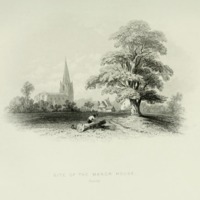Description
Once home to William Brewster, the remains of Scrooby Manor were demolished in the early 19th century. After its associations with Brewster were discovered by the historian Joseph Hunter in the 1840s, its popularity as a site of Pilgrim Fathers memory began to grow. William Henry Bartlett provides the following description of his visit to the site with an accompanying illustration:
"Not a wreck of this sumptuous building now remains, but its position is evidently discernible; and in the annexed view, the farm-house with a row of willow-trees marks its site. Thither I pursued my way, past the mill, and by a few latticed cottages; and, knocking at the door of one of these, the porch of which was overhung with roses that scented the whole neighbourhood, I inquired for the old hall. The door was opened by a respectable old man, who, on learning my object, put on his hat, and said that he would show me the way. We passed a wicket gate, and entered a large enclosure covered with the finest turf, divided from the gardens of the village by what, though dry, had evidently once been a moat. My guide informed me that there were some old men who could remember it filled with water; "but," he added, "it is now dry, and in it you are walking wi' an oud butcher." We perambulated the entire area of the square, one side of which is bounded by the river, and another by the railroad. Almost in the centre stands a noble group of sycamores, marking, as I understood, the site of the principal buildings, and, with the beautiful church in the background, forming a very pleasing picture. We hunted out some fragments of richly-carved woodwork, which had doubtless formerly adorned the halls of state, and had now descended to the " base uses" of propping up the roof of a cow- house. Beyond these insignificant relics there was no trace of the stately "Manor of the Bishops," where these lordly prelates, attended by a splendid retinue, went forth to hawk and to hunt, and returned to feast and to revel, in its days of pride; and where, in its decay, — strange contrast ! — the little band of sufferers for conscience sake, stealing by by-paths from the neighbouring villages, assembled under the hospitable roof of Brewster to practise in secret that form of worship which the persecution of their enemies prevented them from celebrating openly. This now vacant spot was the nucleus of the Pilgrim Church; and here was linked and rivetted that solemn fellowship, and unity of purpose and spirit, which subsisted through manifold perils, until it had laid the foundations of a mighty empire on the distant shore of America."

